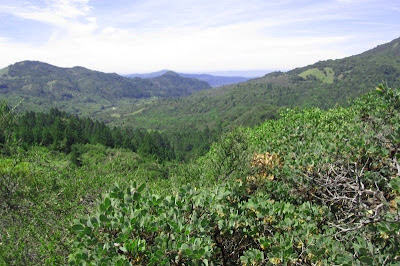
Map of SugarLoaf Ridge, Kenwood, California
Put away your mobiles, tragically not-to-scale posters and science fair projects full of painted foam balls, and pull on your hiking boots. There is a much better way to understand the relative distances of our solar system! I was excited to find a "Solar System Walk" just a few hours from me near the Robert Ferguson Observatory in Sonoma County, also known as the Valley of the Moon.
My friend Karen and I started at the Sun, which had been reduced in size by a factor of two billion, setting the ratio for the rest of the "Planet Walk". In other words, every step forward represents about a million miles. Whoa.

That would be me, waving to Mercury from the Sun
The inner rocky planets are just short hops: 81 feet to Mercury, 149 feet to Venus, 207 feet to Earth and 315 feet to Mars (142 million miles from the Sun). Each planet marker has a handy plaque showing hikers how far they have walked, and how far from they are from the starting point in representative miles.
The first true hike is from Mars to Jupiter. Interestingly, this particular area held many scattered jumbles of loose rocks, and we playfully decided this was the Asteroid Belt. Fitting locale!

Karen on Mars! Again note the sun in the distance
One concept that is truly driven home is the amount of empty space, a concept not found in popular books and posters. If we imagine how large the planets are, the symbolic distances covered in order to reach them feel truly staggering!
The terrain in this particular hike was dotted with beautiful streams, bright wildflowers and rolling tree-covered hills… up until Saturn, when the sounds of civilization dwindled and we crossed into thicker forest. As paths narrowed and began to ascend, and we were grateful we brought plenty of water. Always wise!

Saturn has a surprisingly lovely fern garden
Just before Neptune, someone decided it would be a good idea to ditch the casual trek and send hikers scrambling up gravel-covered inclines… sometimes on all fours for balance! No joke. Jupiter sat at 1079 feet, Saturn at 2,000 feet, Uranus another 4,000 feet and Neptune at the 1.2 mile mark. At this point, looking backward, we could no longer even see the giant Observatory dome, much less the tiny Sun!
Finally, we climbed (literally) to Pluto at just under 2 miles, acutely aware we had to retrace our steps back to the truck in the rising heat. But we celebrated being 3.7 billion miles from the Sun! Awesome view from Pluto, too. Very green.

The view from the Pluto marker on Brushy Peak
From this point, reaching the next nearest star to our sun, Proxima Centauri, would be about 10,000 miles on their scale… which is just a short jaunt to … Tibet. Yeah, Tibet.
For the entire album of the hike, the markers, the measurements and the beautiful terrain of Sugarloaf Ridge, go to my Pillownaut Picasa Gallery!


































































